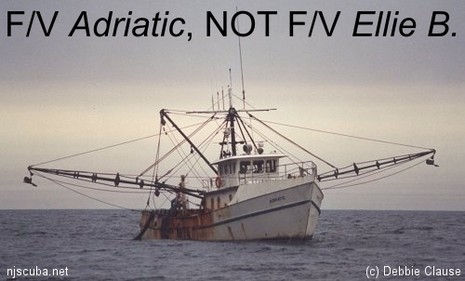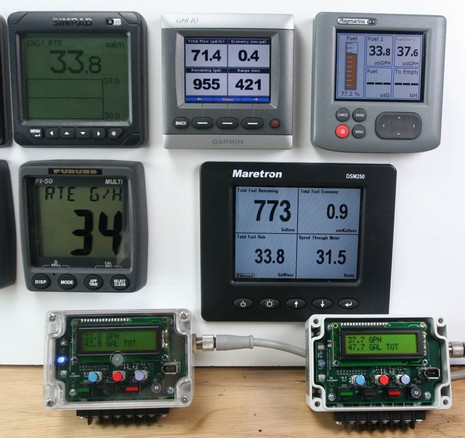SSB backstay antenna, a new way
 I’ve never much liked the practice of inserting insulators in a sailboat’s backstay to create an SSB antenna; I want my backstays in one piece, thank you. Thus the Gam/McKim Split Lead Single Side Band Antenna looks like a much more sensible idea. The new design (bigger drawing here) fits over the stay, is easy to install or remove, and promises better performance with less likelihood of corrosion. Plus it’s “priced to compete with conventional backstay insulators (including swaging costs)”. Nice.
I’ve never much liked the practice of inserting insulators in a sailboat’s backstay to create an SSB antenna; I want my backstays in one piece, thank you. Thus the Gam/McKim Split Lead Single Side Band Antenna looks like a much more sensible idea. The new design (bigger drawing here) fits over the stay, is easy to install or remove, and promises better performance with less likelihood of corrosion. Plus it’s “priced to compete with conventional backstay insulators (including swaging costs)”. Nice.
PS, 7/18: Rumor has it that Sail SSB expert Gordon West tested this antenna and found that it worked as well as an insulated backstay, even when fitted over the grounded stay of a steel boat. I’ve also seen reports that it many cases (depends on wire fittings) it is actually less expensive than the traditional insulator set up. Very nice!













Hmmm…. I’m not an atenna expert, but it seems like they are feed two wire parrellel to the backsty which means all three wires would be “hot” when transmittng so you’d have a random length longwire and you’d need some antenna tuner gear to deal with that I’m assuming. I’ve not looked in the backstay antenna lengths, but I always assumed (again with that word) they were sized to be tuned for the most appropriate frequency. Also it seems like it would expose anyone in the cockpit to more RF closer to their heads than the normal setup. Anyway, this sounds great from a rigging perspective but not so good on its face from a RF perspective. I’m curious what others think though because I’m a very rusty ham.
Good read on SSCA on this… http://www.ssca.org/sscabb/index.php?action=vthread&forum=7&topic=733
Interesting, Patrick, but my BS meter goes into the red zone when I read aggressive bluster like, “This split lead antenna is a scam. It won’t perform worth a damn and is outrageously expensive” from a dude whose idea of good antenna is scrap wire hanging from a spare halliard. Might work ok for a delivery captain, but is that a rig you want to sail around with long term? Apple and orange comparison from an internet troll, I suspect.
IMHO there will be quite a lot more stray RF zinging around the cockpit with this antenna solution than with an inslated backstay. The dual parallel wires simply couple the RF into the wire backstay. The resulting non-resonant antenna element will be comprised of the backstay, both antenna wires, the stern rigging tang, ground plane, the mast and effectively the whole rig…shrouds and all. With an insulated backstay, the 23 ft section that is between the insulators, together with the single conductor high-voltage feedline from the antenna tuner, is chosen to be harmonically related to the majority of the SSB channels desired. Extra metal hanging off the ends of the antenna….the mast, shrouds etc will all be directly RF driven from the tuner. There is enough parasitic RF current zinging around under an end-fed random length SSB antenna without actually connecting the antenna directly to the sailboat’s rigging! I’ll hoist a 23 ft wire on a halyard while saving for a pair of quality insulators. http://64.70.221.24/members/addpubs/sanctuary.pdf
It’s better to build a couple of stainless steel vertical dipoles than to pursue ANY kind of insulated backstay arrangement. You’ll get much better performance.
I noticed that this design runs braided copper thru HDPE. If for a backstay(or double backstay) you were to use amsteel(which is a hollow braid), some other suitable HDPE or UHDPE and run a wire for an antenna thru it. Let’s also say where the wire stopped and started you kinda pushed the HDPE together like a Chinese finger handcuffs and worked in some insulating goop(please suggest what you think best), with the rubbery characteristics of boatlife,waited until it slightly cured and then stretched it(loaded it till full cure). Wouldn’t that work. It seems that type of line is also being used on it’s terminal ends with a loop and lashing. Couldn’t the loop(eye) go around a ceramic insulator, and then lashed, like the kind you sometimes see where telephone guy wires attach near the ground. Also if the insulating idea worked what would the effects be of the slight salty moisture, surrounding the antenna to a slight depth, what would the effect be on the signal? Also there is the benfit that it is more insulated if the antenna was touched.
I believe that sea water/salt saturation and low resistance to the uninsulated backstay would work against this (Amsteel line) approach…
Efficiency looks best in copper….
Material Resistance
(ohm-cmil/ft) (ohm-cm)
Aluminum 15.94 2.650 e-6
Brass 42.1 7.0 e-6
Carbon (amorphous) 3.8-4.1 e-6
Constantan 272.97 45.38 e-6
Copper 10.09 1.678 e-6
Iron 57.81 9.61 e-6
Manganin 290 48.21 e-6
Molybdenum 32.12 5.34 e-6
Nichrome 675 112.2 e-6
Nichrome V 650 108.1 e-6
Nickel 41.69 6.93 e-6
Platinum 63.16 10.5 e-6
Stainless steel (304) 541 90 e-6
Steel (0.5% Carbon) 100 16.62 e-6
Tungsten 31.76 5.28 e-6
Zinc 35.49 5.90 e-6
Hi, I was wondering if Gordon West had any comments on the following groung plane. http://cgi.ebay.com/ebaymotors/KISS-SSB-Marine-Radio-SSB-Ground-Plane-_W0QQcmdZViewItemQQhashZitem19bd5b2b64QQitemZ110551051108QQptZBoatQ5fPartsQ5fAccessoriesQ5fGear
Regards, John Burns.
When I was first getting into sailing, and Marine HAM SSB about 15 years ago, I consulted a couple of sailing RF engineer coworkers of mine at Northrop about HF antennas on our sailboats. They said their experiments with multiple designs, as well as the traditional backstay SSB antenna, showed so much parasitic induction and radiation throughout the rigging, push and pullpit, mast, etc….that there really was no predictable radiation pattern, and concluded the random (or cut-to-length, tuned) wire raised on a halyard, and fed through something like an LDG AT-200 II Pro was at least as good, and spared you the risk and expense of cutting that backstay and installing insulators.
Considering that, I’d say the sky’s the limit, literally. I’ve always been intrigued by the idea of a surplus weather balloon off eBay, filled with helium, lifting as much 16 or 18gauge marine wire as possible, as a big vertical….hoisting the coax feedline by halyard to the top of the mast. I’ll bet that would be fun !
Jeff Stennett, It is true that there are a lot of parasitic losses using an insulated backstay; the shroud and mast are the culprits. But a balloon launched wire would be subject too many variables to make it at all practical, for one thing, you’d constantly be tuning for a changing impedance as the long-wire drifts about. For receiving it would be fine. And if you’re going to have a hoist-able long-wire, you might as well have a backstay antenna. Radios with transistor transmitter finals need to see a constant 52 Ohms impedance, and being limited by space and support structures, means that just about any HF antenna setup on land or sea is a compromise that has to “fool” the transmitter by having the correct impedance at the radio’s antenna terminal connection, since a “perfect antenna” for HF frequencies, frequencies large amounts of space. As an example, a 1/4 wave ground-plane antenna for 7Mhz, designed to have 52 Ohms impedance at the antenna’s feed-point is like a giant Mercedes-Benz star symbol, with the driven element being the vertical line of the “star” being 10 meters long, and the drooping legs of the “star”, forming the ground-plane return, also being each 10 meters long, with a third leg equidistant from the other two (think tripod). Getting the angles correct to create 52 Ohms impedance, let-alone the materials that could hold their shape without insulated support structure, would be a quite a trick on a boat. This is not to mention that most HF antennas are horizontally polarized, and therefore are fairly directional in their propagation characteristics.
has an overall length of 20 meters. So if the insulated length of your backstay is about 30′, you’ve got a shot at, at least some kind of inverted V antenna with a terminal impedance that would likely be less than 52 Ohms that would have to be tuned out with a coil or an antenna tuner. Ships in the old days had their HF antenna stretched between masts, parallel to the water, and not an ideal distance from the conductive surface of the ship itself. this meant the ship’s propagation was likely a very high angle, and relied on ionospheric skip, this also meant that someone 1500 miles away could likely receive that ship’s transmission better than someone 200 miles away.
What makes any type of antenna that is as large as the backstay, desirable, is what’s called “capture area”; this is the fact that a perfectly tuned small antenna, will still not induce as large a current (for reception) as a longer antenna, that is poorly tuned. As far as RF exposure near the backstay, I’d say you do want to insulate the wire with at least a length of plastic tubing to prevent someone getting an RF burn if they happen to be touching it while someone is transmitting. As far as proximity exposure, remember that the power of the transmitter that actually makes it to the antenna, is being dissipated over the 30′ length of the backstay, and given its low frequency, it’s not akin to being exposed to microwaves of say your cell phone. Also, unlike VHF FM transmissions, which are the same output power during an entire transmission, SSB transmission power varies directly with speech input of the microphone, this is what makes SSB so efficient.
As far as the featured antenna, I’d have to study it more, but it seems to me that if the concern is the strength of the insulators, maybe just figure out a way to double-up on them, and halve the load on each.